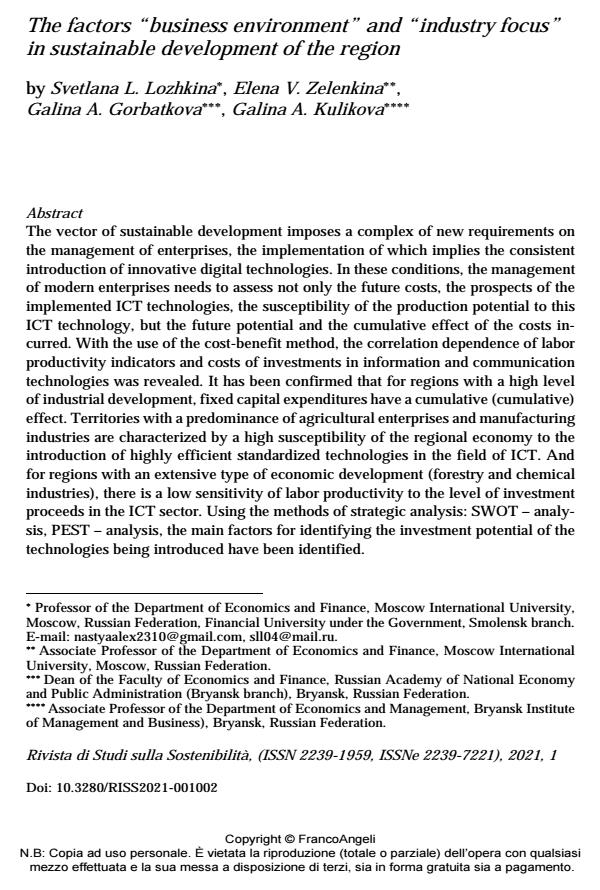The factors "business environment"and "industry focus" in sustainable development of the region
Journal title RIVISTA DI STUDI SULLA SOSTENIBILITA'
Author/s Svetlana L. Lozhkina, Elena V. Zelenkina, Galina A. Gorbatkova, Galina A. Kulikova
Publishing Year 2021 Issue 2021/1
Language English Pages 18 P. 11-28 File size 173 KB
DOI 10.3280/RISS2021-001002
DOI is like a bar code for intellectual property: to have more infomation
click here
Below, you can see the article first page
If you want to buy this article in PDF format, you can do it, following the instructions to buy download credits

FrancoAngeli is member of Publishers International Linking Association, Inc (PILA), a not-for-profit association which run the CrossRef service enabling links to and from online scholarly content.
The vector of sustainable development imposes a complex of new requirements on the management of enterprises, the implementation of which implies the con-sistent introduction of innovative digital technologies. In these conditions, the management of modern enterprises needs to assess not only the future costs, the prospects of the implemented ICT technologies, the susceptibility of the produc-tion potential to this ICT technology, but the future potential and the cumulative effect of the costs incurred. With the use of the cost-benefit method, the correla-tion dependence of labor productivity indicators and costs of investments in in-formation and communication technologies was revealed. It has been confirmed that for regions with a high level of industrial development, fixed capital expendi-tures have a cumulative (cumulative) effect. Territories with a predominance of agricultural enterprises and manufacturing industries are characterized by a high susceptibility of the regional economy to the introduction of highly efficient standardized technologies in the field of ICT. And for regions with an extensive type of economic development (forestry and chemical industries), there is a low sensitivity of labor productivity to the level of investment proceeds in the ICT sec-tor. Using the methods of strategic analysis: SWOT - analysis, PEST - analysis, the main factors for identifying the investment potential of the technologies being introduced have been identified.
Keywords: information and communication technologies (ICT), factors, invest-ment attractiveness, region, industry focus.
- What business environment element configuration can promote urban digitization development? Hongxia Zhao, Hongyang Chen, Huijuan Zhao, Ying Lu, Jianhua Zhu, in Environment, Development and Sustainability /2023 pp.27923
DOI: 10.1007/s10668-023-03794-w
Svetlana L. Lozhkina, Elena V. Zelenkina, Galina A. Gorbatkova, Galina A. Kulikova, The factors "business environment"and "industry focus" in sustainable development of the region in "RIVISTA DI STUDI SULLA SOSTENIBILITA'" 1/2021, pp 11-28, DOI: 10.3280/RISS2021-001002